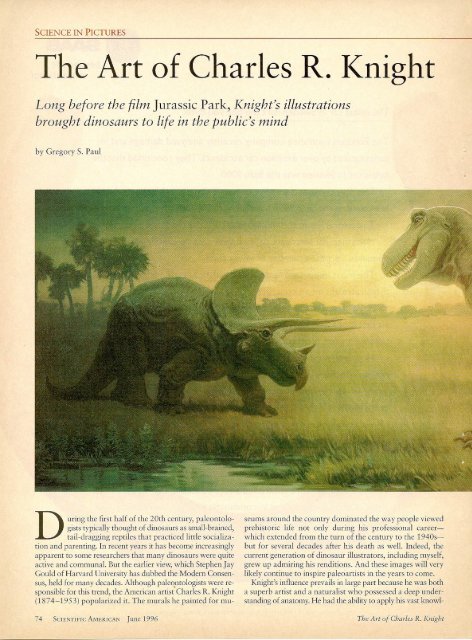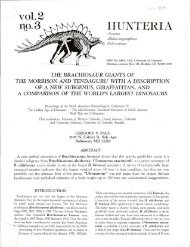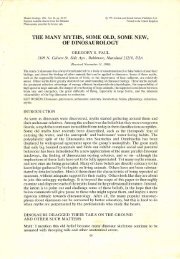The Art of Charles R. I(night - Gregory S. Paul
The Art of Charles R. I(night - Gregory S. Paul
The Art of Charles R. I(night - Gregory S. Paul
Create successful ePaper yourself
Turn your PDF publications into a flip-book with our unique Google optimized e-Paper software.
SCIENCE IN PICTURES<br />
<strong>The</strong> <strong>Art</strong> <strong>of</strong> <strong>Charles</strong> R. I(<strong>night</strong><br />
Long before the film Jurassic Park, K<strong>night</strong>'s illustrations<br />
brought dinosaurs to life in the public's mind<br />
by <strong>Gregory</strong> S. <strong>Paul</strong><br />
During the first half <strong>of</strong> the 20th century, paleontologists<br />
typically thought <strong>of</strong> dinosaurs as small-brained,<br />
tail-dragging reptiles that practiced little socialization<br />
and parenting. In recent years it has become increasingly<br />
apparent to some researchers that many dinosaurs were quite<br />
active and communal, But the earlier view, which Stephen Jay<br />
Gould <strong>of</strong> Harvard University has dubbed the Modern Consensus,<br />
held for many decades. Although paleontologists were responsible<br />
for this trend, the American artist' <strong>Charles</strong> R. K<strong>night</strong><br />
(1874-1953) popularized it. <strong>The</strong> murals he painted for mu-<br />
74 SCIENTIFIC AMERICAN June 1996<br />
seums around the country dominated the way people viewed<br />
prehistoric life not only during his pr<strong>of</strong>essional careerwhich<br />
extended from the turn <strong>of</strong> the century to the 1940sbut<br />
for several decades after his death as well. Indeed, the<br />
current generation <strong>of</strong> dinosaur illustrators, including myself,<br />
grew up admiring his renditions. And these images will very<br />
likely continue to inspire paleo artists in the years to corne.<br />
K<strong>night</strong>'s influence prevails in large part because he was both<br />
a superb artist and a naturalist who possessed a deep understanding<br />
<strong>of</strong> anatomy. He had the ability to apply his vast knowl-<br />
<strong>The</strong> <strong>Art</strong> <strong>of</strong> <strong>Charles</strong> R. K<strong>night</strong>
DEADLY ENEj\tllES,<br />
a horned Triceratops and towering Tyrannosaurus,<br />
meet face to face in <strong>Charles</strong> R. K<strong>night</strong>'s most influential<br />
mural (below), painted in the late 1920s. Such<br />
paintings still set high standards for today's paleoartists.<br />
Relying on his vast knowledge <strong>of</strong> anatomy<br />
and his vivid imagination, K<strong>night</strong> rendered many<br />
detailed images <strong>of</strong> prehistoric animals. For example,<br />
although the model Stegosaurus he created in 1899<br />
(photograph at right) bears too many plates by<br />
current standards, it carries them in the alternating<br />
pattern now accepted.<br />
edge <strong>of</strong> anatomical structure to make prehistoric creatures<br />
come alive again. His paintings remain on display at many museums,<br />
including the Field Museum <strong>of</strong> Natural History in<br />
Chicago and the Natural History Museum <strong>of</strong> Los Angeles<br />
County, and they form an important part <strong>of</strong> the new dinosaur<br />
halls at the American Museum <strong>of</strong> Natural History in<br />
New York City.<br />
<strong>The</strong> first published account <strong>of</strong> fossils that today are believed<br />
to be from a dinosaur appeared in 1824. Throughout<br />
the 1800s, scientists collected numerous teeth and bones from<br />
<strong>The</strong> <strong>Art</strong> <strong>of</strong> <strong>Charles</strong> R. K<strong>night</strong><br />
excavations in Europe and the U.S. <strong>The</strong> public naturally clamored<br />
for descriptions <strong>of</strong> the long-gone giants. But the jumbled<br />
skeletons the fossil hunters found <strong>of</strong>fered only sketchy information<br />
to artists hoping to re-create the prehistoric animals.<br />
<strong>The</strong> most notable effort to satisfy society's curiosity came from<br />
Richard Owen, the preeminent paleontologist who coined the<br />
name "Dinosauria" in 1841. In 1854 he commissioned fullsize<br />
dinosaur sculptures-which are still standing today-for<br />
the grounds <strong>of</strong> the Crystal Palace in London.<br />
<strong>The</strong> only complete skeleton unearthed before the 1880s<br />
SCIENTIFIC AMERICAN June 1996 75
came from Germany: a small, carnivorous, birdlike animal<br />
named Compsognathus. <strong>The</strong> situation improved dramatically<br />
during the 1870s and 1880s, when scientists began<br />
to excavate the dinosaur-rich sediments in the arid<br />
western U.S. <strong>The</strong>re they uncovered whole skeletons <strong>of</strong><br />
sauropods, predaceous allosaurs and plated stegosaurs<br />
from the Jurassic period. Knowledge about the shape and<br />
size <strong>of</strong> dinosaurs quickly started to accumulate. Shortly<br />
thereafter, in the 1890s, K<strong>night</strong> began painting them.<br />
Despite his good timing, it is somewhat remarkable that<br />
he became the most famous dinosaur artist. <strong>of</strong> his time.<br />
K<strong>night</strong> was a sensitive character prone to phobias. And<br />
although he showed early promise-he began drawing animals<br />
and landscapes at age five or six-he was very nearsighted.<br />
In addition, a severe injury to his right eye during<br />
TAR PITS AT RANCHO LA BREA<br />
in California were painted by K<strong>night</strong> in the 1920s, some 15<br />
years after their excavation in 1906. <strong>The</strong> deposit yielded a<br />
vast number <strong>of</strong> Ice Age fossils, including those from sabertoothed<br />
cats, cave lions, elephants, mastodons, sloths, camels,<br />
horses, coyote, bison, antelope and birds. Unlike his<br />
drawings <strong>of</strong> dinosaurs, K<strong>night</strong>'s paintings <strong>of</strong> mammals typically<br />
showed a great deal <strong>of</strong> action. So, too, skeletal mounts<br />
<strong>of</strong> mammals made in conjunction witlr K<strong>night</strong>'s murals,<br />
such as the sloths at the American Museum <strong>of</strong> Natural History<br />
in New York City (photograph), took animated poses.<br />
76 SCIENTIFIC AMERICAN June 1996 <strong>The</strong> <strong>Art</strong> <strong>of</strong> <strong>Charles</strong> R. K<strong>night</strong>
,'\<br />
Jl<br />
DUCK-BILLED DINOSAURS<br />
<strong>of</strong> the genus Anatosaurus were painted by K<strong>night</strong> in 1909<br />
(painting at left). He based the composition on two skeletons<br />
mounted at the American Museum <strong>of</strong> atural History. In the<br />
museum's newly renovated dinosaur halls, the mounts and K<strong>night</strong>'s<br />
painting are on display side by side.<br />
childhood further impaired his vision. All the same, encouraged<br />
by the adults around him, including an artistic<br />
stepmother and a talented family friend, K<strong>night</strong> attended<br />
a series <strong>of</strong> art schools in and around ew York City as he<br />
grew older. At age 16, he got his first, and only, full-time<br />
job, painting nature scenes for church decorations.<br />
Quickly thereafter, K<strong>night</strong> moved from Brooklyn-and<br />
away from his increasingly jealous stepmother-to Manhattan.<br />
He soon launched a successful freelance career as<br />
an illustrator for several natural history publications. He<br />
enjoyed going to the city's zoos and parks and chronicled<br />
his trips by making numerous, meticulous sketches <strong>of</strong><br />
animals, plants and other objects. <strong>The</strong> exercise enhanced<br />
his work, as did his habit <strong>of</strong> visiting the American Museum<br />
<strong>of</strong> Natural History. <strong>The</strong>re he honed his knowledge <strong>of</strong><br />
anatomy by dissecting carcasses. It was also at the museum<br />
that K<strong>night</strong> found his calling, when a paleontologist<br />
there asked him as a favor to create a replica <strong>of</strong> an extinct<br />
mammal.<br />
After an extended trip to Europe-during which he<br />
studied art and visited even more zoos-K<strong>night</strong> turned<br />
his attention to dinosaurs almost exclusively. He went to<br />
work for a short while under Edward Drinker Cope, just<br />
before the renowned vertebrate paleontologist died. Cope<br />
and his rival, Othniel C. Marsh <strong>of</strong> Yale College, had<br />
brought about the first great rush <strong>of</strong> American interest in<br />
dinosaurs during the 1870s.<br />
But K<strong>night</strong> formed his most important association again<br />
at the American Museum <strong>of</strong> Natural History, collaborating<br />
with the aristocratic paleontologist Henry Fairfield Osborn.<br />
As director <strong>of</strong> the museum, Osborn wanted someone<br />
to translate his collections <strong>of</strong> dry bones into captivating,<br />
living images. Such pictures, he thought, could draw<br />
<strong>The</strong> <strong>Art</strong> <strong>of</strong> <strong>Charles</strong> R. K<strong>night</strong> SCIENTIFIC AMERICAN June 1996 77
crowds and make his museum the leading center<br />
<strong>of</strong> natural science.<br />
K<strong>night</strong> quickly won attention for the museum<br />
and for himself, fashioning restorations that<br />
reflected many <strong>of</strong> Osborn's early ideas. Osborn<br />
proposed, for example, that sauropods may<br />
have been terrestrial high browsers, and so, under<br />
Osborn's direction, K<strong>night</strong> painted just such -<br />
a sauropod-a brontosaur-rearing up on its<br />
hind legs as though in search <strong>of</strong> foliage [see illustration<br />
at right]. K<strong>night</strong> also showed large<br />
theropods-the most successful predatory dinosaurs-leaping<br />
into the air [see upper illustration<br />
on opposite page]. Although he was<br />
correct to characterize these theropods as agile<br />
hunters, most paleontologists <strong>of</strong> the time rejected<br />
that notion.<br />
During the early 20th century, digs in North<br />
America and Asia produced remnants <strong>of</strong> remarkable<br />
dinosaurs from the Late Cretaceous period-among<br />
them terrible tyrannosaurs, horned<br />
ceratopsians, duck-billed hadrosaurs and armored<br />
ankylosaurs. K<strong>night</strong>'s paintings from this<br />
time-primarily murals for the American Museum<br />
<strong>of</strong> Natural History and for the Field Museum<br />
<strong>of</strong> Natural History-were sophisticated<br />
works <strong>of</strong> art. He typically painted misty scenes,<br />
possibly because <strong>of</strong> his poor long-range vision,<br />
filled with finely rendered, highly realistic figures<br />
<strong>of</strong> well-known dinosaurs. <strong>The</strong>se were<br />
K<strong>night</strong>'s most productive years, and his illustrations<br />
became the world's most celebrated.<br />
K<strong>night</strong>'s personal life was also at its zenith<br />
during the 1920s. He and his wife, the spirited ~<br />
Annie Hardcastle, were a popular couple on ~<br />
New York's social scene. Annie secured a com- ~<br />
fortable life for them, managing all K<strong>night</strong>'s ~<br />
money matters, from his pocket change to his<br />
payments for paintings (he was notoriously absentminded<br />
about finances). At age 13, their<br />
daughter, Lucy, took charge. Seven years later,<br />
she successfully obtained $150,000 from the<br />
Field Museum for her father's murals on display<br />
there. In the 1930s K<strong>night</strong> augmented his<br />
income by giving lectures, and his authority expanded<br />
even further. Today dinosaur restoration<br />
is a minor industry, practiced around the<br />
world. Necessarily, much <strong>of</strong> the romance that<br />
K<strong>night</strong> enjoyed-having been almost alone in<br />
the field-has disappeared.<br />
REARJNG SAUROPOD,<br />
which K<strong>night</strong> painted early in his career, near the<br />
turn <strong>of</strong> the century, was influenced by one <strong>of</strong> the<br />
theories <strong>of</strong> the paleontologist Henry Fairfield Osborn-namely,<br />
that such dinosaurs might have<br />
been terrestrial high browsers (painting). Most<br />
paleontologists rejected the idea at the time;<br />
even so, the famed barosaur installed in 1991<br />
in the entry hall <strong>of</strong> the American Museum <strong>of</strong><br />
Natural History to greet visitors is mounted<br />
in the same position (photograph).<br />
78 SCIENTIFIC AMERICAN June 1996
FIGHTING CARNIVORES<br />
<strong>of</strong> the genus Dryptosaurus are shown<br />
here as they were described by the paleontologist<br />
Edward Drinker Cope.<br />
K<strong>night</strong> completed the painting in<br />
1897, shortly after Cope died. Within<br />
a decade, most scientists frowned on<br />
the idea that these dinosaurs leaped<br />
into the air. Some scientists now think<br />
these theropods may have been quite<br />
aggressive hunters.<br />
SMALL PROTOCERATOPS<br />
were painted by K<strong>night</strong> in 1922, shortly<br />
after the first dinosaur nests were<br />
uncovered in Mongolia. At Osborn's<br />
suggestion, K<strong>night</strong> depicted the ceratopsian<br />
dinosaurs protecting their<br />
eggs. (Recently experts at the American<br />
Museum <strong>of</strong> Natural History demonstrated<br />
that these eggs actually belonged<br />
to Oviraptor.) <strong>The</strong> painting can<br />
now be seen at the Field Museum<br />
<strong>of</strong> Natural History in Chicago.<br />
<strong>The</strong> <strong>Art</strong> <strong>of</strong> <strong>Charles</strong> R. K<strong>night</strong> SCIENTIFIC AMERICAN June 1996 79
K<strong>night</strong> worked in close collaboration with paleontologists.<br />
Thus, his art reflects the scientific dogmatism <strong>of</strong> his times. This<br />
dogmatism was by no means absolute, however. For example,<br />
in Life through the Ages-a catalogue <strong>of</strong> dinosaurs K<strong>night</strong><br />
compiled in 1946-he called dinosaurs "unadaptable and unprogressive"<br />
and "slow-moving dunces" that were well suited<br />
for extinction in favor <strong>of</strong> "alert, little warm-blooded" mammals.<br />
But on the same page he noted that one predaceous dinosaur<br />
was "lightly constructed for quick action, and fairly<br />
80 SCIENTIFIC AMERICAN June 1996<br />
sagacious for a reptile." And he did not always draw dinosaurs<br />
as "typical" reptiles. In one painting he depicted a pair<br />
<strong>of</strong> Triceratops watching over a youngster. On occasion he<br />
placed social groups <strong>of</strong> plant-eating dinosaurs in his work.<br />
And after the discovery <strong>of</strong> dinosaur nests in Central Asia, he<br />
painted, at Osborn's suggestion, diminutive protoceratopsids<br />
guarding their eggs.<br />
<strong>The</strong> limitations <strong>of</strong> the time are most apparent in K<strong>night</strong>'s<br />
best-known piece, showing a lone, horned Triceratops facing<br />
down two Tyrannosaurus [see illustration<br />
on pages 74 and 75]. K<strong>night</strong><br />
did not know that enormous beds <strong>of</strong><br />
bones would eventually reveal that<br />
some horned dinosaurs lived in herds.<br />
Moreover, in K<strong>night</strong>'s picture, little<br />
action takes place between the herbivore<br />
and its predators. Every foot is<br />
planted firmly on the ground. In fact,<br />
the "every-foot-on-the-ground" rule<br />
is true <strong>of</strong> almost all K<strong>night</strong>'s dino-<br />
HORNED AGATHAUMAS,<br />
one <strong>of</strong> K<strong>night</strong>'s earliest works, was<br />
finished under the direction <strong>of</strong> Cope<br />
in 1897 for the American Museum <strong>of</strong><br />
Natural History. During Cope's day,<br />
paleontologists <strong>of</strong>fered many fanciful<br />
and unsubstantiated descriptions <strong>of</strong><br />
dinosaurs. <strong>The</strong> animal shown at the<br />
left sports what would seem by current<br />
standards to be an extreme number<br />
<strong>of</strong> adornments.<br />
<strong>The</strong> <strong>Art</strong> <strong>of</strong> <strong>Charles</strong> R. K<strong>night</strong>
saur figures. Although he frequently drew mammals, even<br />
large ones, walking and running, he almost never depicted<br />
dinosaurs doing so. K<strong>night</strong> most <strong>of</strong>ten colored dinosaurs in<br />
rather drab shades <strong>of</strong> solid dun and green. Dinosaurs may<br />
have been such hues, but they probably had color vision<br />
much like reptiles and birds, and their scaly skins would have<br />
been suitable bases for more intense pigmentation. For these<br />
reasons, most <strong>of</strong> today's artists <strong>of</strong>ten apply vivid colors to<br />
their dinosaurs.<br />
K<strong>night</strong> used his vast knowledge <strong>of</strong> anatomy to make extinct<br />
forms appear so real that his viewers could easily believe<br />
he had seen them. This ability no doubt explains why his pictures<br />
continue to look plausible today. But this seeming realism<br />
was in some ways superficial. Although K<strong>night</strong> sketched<br />
detailed musculoskeletal studies <strong>of</strong> living animals, he did not<br />
produce similar studies <strong>of</strong> dinosaurs-in part because skeletons<br />
reveal limited information about an animal's musculature.<br />
Instead K<strong>night</strong> drew skeletal mounts, made rough<br />
sculptures or composed life restorations freehand-a tradition<br />
in which many dinosaur artists have followed.<br />
One particular anatomical convention that K<strong>night</strong> practiced<br />
perplexed me when I was a budding dinosaur artist in the<br />
<strong>The</strong> Author<br />
GREGORY S. PAUL has published his<br />
artwork in Nature, Smithsonian and Science<br />
News and has written articles for many pr<strong>of</strong>essionaljournals.Afreelancedinosaurscholar<br />
and illustrator,<strong>Paul</strong> studied at Johns HopkinsUniversityand<br />
residesin Baltimore,Md.<br />
NORTH AMERICAN DINOSAURS<br />
from the Upper Cretaceous period<br />
are seen in this mural, which K<strong>night</strong><br />
painted in the late 1920s for the Field<br />
Museum <strong>of</strong> Natural History. Moving<br />
through this somewhat misty scene,<br />
a variety <strong>of</strong> creatures stand out, including,<br />
from left to right, a helmetcrested<br />
Corythosaurus, a herd <strong>of</strong><br />
Parasaurolopbus, an armored Palaeoscincus,<br />
several Struthiomimus<br />
and a few flat-headed hadrosaurs<br />
(called Edmontosaurusi.<br />
late 1960s-back in the days before<br />
the idea that dinosaurs were energetic<br />
had gained any popularity. I knew<br />
that dinosaurs were considered to be<br />
reptiles and that lizards and crocodilians<br />
have narrow thigh muscles attached<br />
to small hips. Consistent with<br />
this theory, K<strong>night</strong> made his dinosaurs<br />
with narrow, reptilelike thighs.<br />
Yet looking at skeletons, I thought<br />
that dinosaurs seemed to be built<br />
more like birds and mammals, with<br />
large hips anchoring broad thigh<br />
muscles. What was a teenage dino-artist<br />
to do? I copied my hero K<strong>night</strong>,<br />
even though Alfred S. Romer, the esteemed<br />
vertebrate paleontologist <strong>of</strong><br />
Harvard, had correctly depicted big-hipped dinosaurs with<br />
broad, birdlike thigh muscles in his classic 1920s studies <strong>of</strong><br />
the evolution <strong>of</strong> tetrapod musculature. <strong>The</strong> paradox was resolved<br />
in the 1970s, when the new hypothesis that dinosaurs<br />
were "warm-blooded" at last emerged. An animal having<br />
broad hips and large thigh muscles would need to have an<br />
aerobic system capable <strong>of</strong> sustaining high levels <strong>of</strong> activity<br />
for extended periods.<br />
<strong>Art</strong>ists are a bit like magicians: we use optical illusions to<br />
fool people into thinking they are seeing a version <strong>of</strong> reality.<br />
Because one's bag <strong>of</strong> optical tricks gets bigger with time, most<br />
artists tend to get better with age. K<strong>night</strong>'s last decade <strong>of</strong><br />
restorations, however, did not meet his earlier standards. Deteriorating<br />
eyesight may have been the culprit. Also, Osborn<br />
was long departed, and the Great Depression and World War<br />
II had sent dinosaurology into an era <strong>of</strong> quiescence that did<br />
not lift for 30 years. K<strong>night</strong> never knew <strong>of</strong> dinosaur nesting<br />
grounds, the mass migration <strong>of</strong> herds, polar habitats, the shape<br />
<strong>of</strong> Apatosaurus's head, giant meteoritic impacts, or the fact<br />
that birds are living dinosaurs. Even so, his re-creations currently<br />
set the highest standards for artistic quality-and they<br />
keep motivating those <strong>of</strong> us who follow in his footsteps. IilJ<br />
Further Reading<br />
LIFETHROUGHTHEAGES.<strong>Charles</strong> R. K<strong>night</strong>. AlfredA. Knopf, 1946.<br />
DI OSAURS, MAMMOTHS, D CAVEMEN. S.M. Czerkas and D. F.Glut. E. P.Dutton, 1982.<br />
DI OSAURSPASTAt'lDPRESENT. Edited by S. J. Czerkas and E. C. Olson. University <strong>of</strong><br />
Washington Press, 1987.<br />
THEDI OSAURSOCIETY'SDINOSAURENCYCLOPEDIA. Don Lessem and Donald F. Glut.<br />
Random House, 1993.<br />
<strong>The</strong> <strong>Art</strong> <strong>of</strong> <strong>Charles</strong> R. K<strong>night</strong> SCIENTIFICAMERICANJune 1996 81









